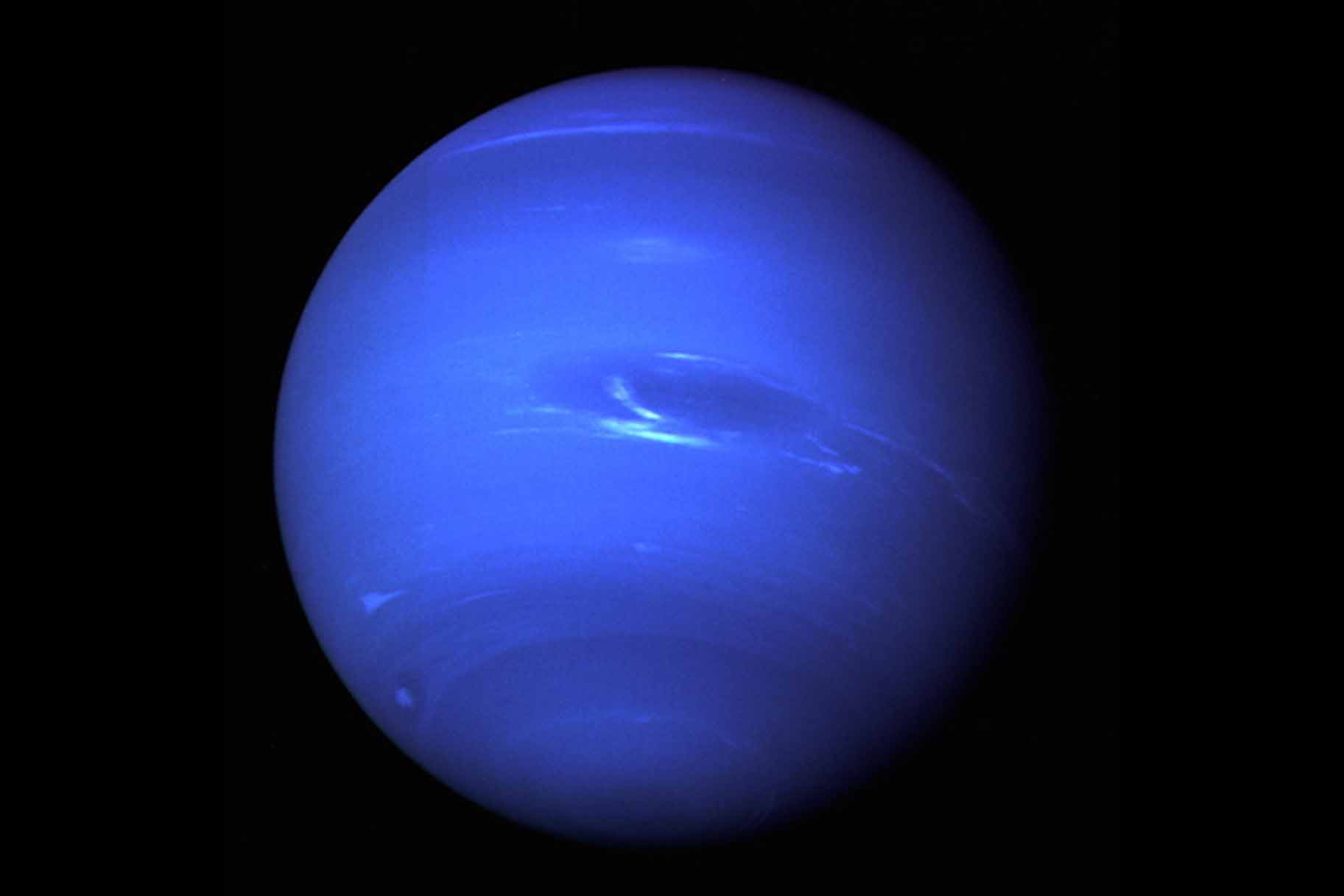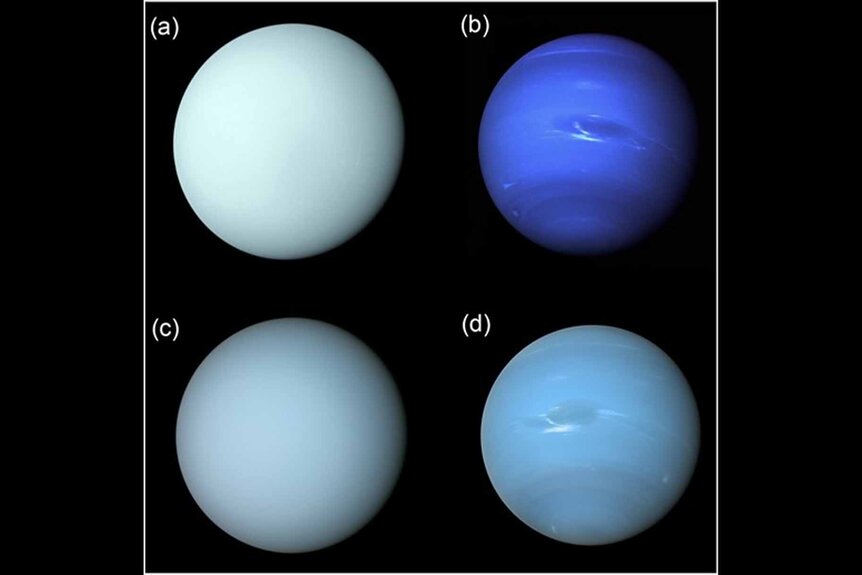Create a free profile to get unlimited access to exclusive videos, sweepstakes, and more!
See Neptune's Real True Colors, Like Never Before
Apparently we've been looking at Neptune all wrong.

In SYFY’s The Ark (streaming now on Peacock), the passengers of humanity’s most crucial lifeboat, Ark One, embark upon the most important deep space mission in the history of our species. An interstellar ship filled with stasis pods will carry them from Earth to the Proxima centauri system 4.2 light-years away. A journey of that length would take too long to keep everyone eating, breathing, and alive for the duration, so they’ll sleep most of the way, at least until something goes terribly wrong, but if they stayed awake, they’d be treated to sights never before seen by human eyes.
As they exited the solar system, they might pass by two planetary waypoints: the ice giants Uranus and Neptune. And if they did, they’d be able to settle a misconception which has taken root in the public consciousness for decades regarding the true color of those distant worlds. Fortunately, we don’t need to go to all that trouble. A team of scientists recently published color corrected images of Neptune which present it in a more realistic light.
Forget Everything You Know About What Neptune Looks Like, Behold Its Real, True Colors
Telescopes of all varieties gather information from the electromagnetic spectrum to make their images. Some of that light is visible, the stuff we can see with our eyes, and some of it isn’t. X-rays, infrared, and radio waves are all kinds of light which are imperceptible to us but can be detected by machines. That means that we’re only seeing a small portion of reality as we walk through the world.
RELATED: JWST’s Neptune: The Best Infrared View in 30 Years
What we’re seeing isn’t what’s really there, it’s just a representation of the environment created by our brains using the sensory information it has available. Telescopes have access to more of the light spectrum but they still have to make concessions in the way information is presented. What is a telescope to do with invisible light to make it visible, rather than to assign it a color it doesn’t have? Moreover, electronic displays and printed images are often incapable of displaying all of the data captured by an imaging instrument. In the strictest sense, all images are only approximations of the truth, but that’s especially the case in astronomy.
When the Voyager 2 spacecraft first passed by the ice giants in the 1980s, it sent back images of both planet’s surfaces. The images of Uranus which made their way to the public were pretty close to its true color, but Neptune was more significantly modified. Astronomers presented it with a richer, deeper blue in an effort to better illustrate its atmospheric features. That’s a common practice in astronomy so that scientists can get a better look at the most interesting characteristics, but it can lead to misconceptions among the public.
“Although the early Uranus images were processed to yield approximately their ‘true’ color, the early-Neptune images were contrast-enhanced to accentuate fainter features and do not accurately represent the true color of this planet,” study authors said, in The Monthly Notices of the Royal Astronomical Society. “This was well known and of concern to planetary scientists at the time, and followed on from earlier debates on how the Voyager images of Jupiter and Saturn should best be presented. However, the subtleties of how these filter-imaging observations were combined to generate color images was lost on the general public.”
Neptune Is a Paler Blue Than We Previously Thought
To better understand what’s happening, let’s visit a world closer to home. Landers and rovers have returned incredible images from the surface of Mars, but it can be difficult to know if what you’re seeing is accurate. The problem is well illustrated by an image taken by the Curiosity Rover in the first weeks of its mission on Mars. The Martian landscape, captured by the rover’s Mast Camera, is presented in three ways. The first is an uncorrected color image, the second has been corrected to present a “true” image of Mars, and the last is what we think it would look like if the Martian terrain were seen beneath Earthly skies. Those last two are different because the variance in Earth and Mars’ atmospheres casts a different light onto the alien ground. Our eyes and our machines both create images of the environment around them and we’re really trying to get those images to line up.
Scientists used data from the Hubble Space Telescope and the Very Large Telescope, both of which capture data from across the color spectrum, to correct the images of Neptune and achieve a truer view. When corrected, Uranus and Neptune become nearly twin planets with an incredibly similar coloration.
While there is some difference in the color of Uranus and Neptune, it isn’t nearly as dramatic as the Voyager 2 images would have us believe. In fact, if you saw both worlds in a lineup you might have trouble telling them apart. Both planets give off a blue-green color because of high concentrations of methane, between 2 and 5 percent, in their upper atmospheres. Methane absorbs light in the green and red parts of the spectrum but reflects blue, giving the ice giants their characteristic hue.
RELATED: Defying death, a monster storm on Neptune makes a U-turn
It’s not that the original coloration of Neptune was wrong, so much as it is that our perception of color is flexible. The precise color of a thing is less important to our brains than the contrast between colors. That’s the reason a painter can use a single color as a highlight in one part of a painting and a shadow in another. Despite being the same pigment, a viewer will experience those two points as different colors because of the surrounding context. Cameras, telescopes, and human image processors have to make similar decisions about the colors used in images, in order to make them readable.
If left uncorrected, astronomical images might have important information hidden in areas of the image that are washed out by intense light. Shifting the intensity necessarily means shifting the overall color. Presenting astronomical images is a constant tightrope walk between gathering useful information and presenting an accurate vision of the universe. It’s a balance we’ll have to keep up, but updated images of Neptune and other celestial objects is a step toward that goal.
Of course, we could always build a ship and go find out for ourselves. Catch the first season of The Ark streaming now on Peacock.































